旧书新读 | 什么是英文写作里的清晰 (clarity)? 读 “Style: The Basics of Clarity and Grace”
date
Oct 8, 2022
slug
what-is-clarity
status
Published
summary
“Clarity” 在美式英文的写作教程中无处不在,但外国人常常因为这个概念的模糊性备受折磨。作为一个写英语的外国人,我花了很多年也没能写得一篇清晰的文章。与我不同,这本令我一口气读完的杰作,《风格:清晰和优雅的基础》清楚明白地解决了这个难题。
tags
Academic
English
Study
TOEFL
type
Post
auth
什么是好的写作风格? 这个问题对外国人可算“杀人诛心”。 一个典型的外国学习者很难理解 “清晰”(clarity) 这个在美国最流行的范式。 幸运的是,在这本书中它是个可理解的想法。 正如它的名字《风格:清晰和优雅的基础》,这本书清晰地解决了这个难题,是一部令我一口气读完的杰作。
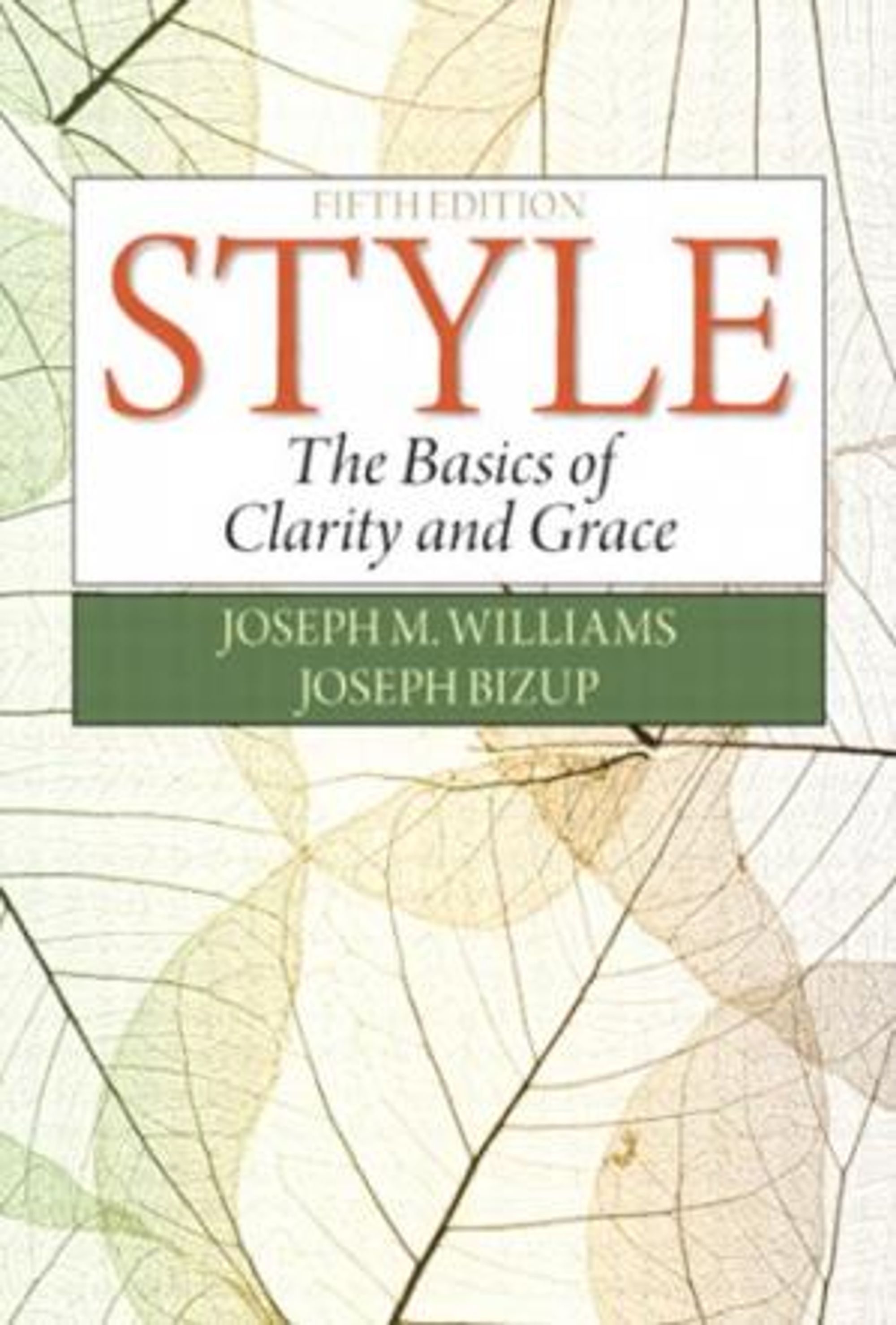
在正式讨论前,作者提及一种哲学:写作简明性是好的且并非遥不可及。尽管一些作品因为行文考虑有限或为读者的考量欠佳而并不清晰,但一个成功的风格仅仅需要做到两件事:清晰的句子和优雅的编排。简短介绍后,本书将这两要素转化为了可操作的原则,如下:
理解风格 (style)动作角色提供角色重建不在场的角色作为角色的抽象名称角色与被动语态被动语态与客观/我们&被动语态、角色和元话语(metadiscourse)连续名词(Noun + Noun + Noun )连贯性和一致性连贯性(cohesion)一致性(coherence)强调动机整体一致性简明形态雅致风格伦理
理解风格 (style)
- Clarity and Understanding: this book rests on two beliefs:
- It is good to write clearly
- And anyone can do it
- The Lure of Obscurity: common
- Private Causes of Unclear Writing
- Social problem
- Some private causes:
- Hoping that complicated sentences will indicate deep thought
- Not deliberately
- Not understand
- Biggest: we don’t know when readers will think we are unclear, much less why.
- On Writing and Reading
Understanding based on our ways of reading
- On Writing and Rewriting
Rewriting improves writing
动作
- Why
A sentence seems clear when its important actions are in verbs
- How
- Principle of Clarity 1: Make Main Characters Subjects
- Principle of Clarity 2: Make Important Actions Verbs
- Professional writing is similar to fairy tales
- Nominalization: A noun derived from a verb or an adjective has a technical name; common patterns to change:
- The nominalization is the subject of an empty verb such as be, seems, or has:
- The nominalization follows an empty verb
- One nominalization is the subject of an empty verb and a second nominalization follows it
- A nominalization follows there is or there are
- Two or three nominalizations in a row are joined by prepositions:
- Positive outcomes
Comparison | Concrete | Concise | Clearer | Coherent |
Before | There was an affirmative decision for expansion. | A revision of the program wiLL resuLt in increases in our efficiency in the servicing of clients. | Our more effective presentation of our study resulted in our success, despite an earlier start by others | Decisions in regard to administration of medication despite inability2 of an irrational patient appearing1 in a trauma center to provide legal consent3 rest with the attending physician alone. |
After | The director decided to expand the program | If we revise the program, we can serve clients more efficiently. | Although others started earlier, we succeeded because we presented our study more effectively. | When a patient appears in a trauma center and behaves so irrationally that he cannot legally consent to treatment, only the attending physician can decide whether to medicate5 him. |
角色
提供角色
- 为什么
- Characters are important
- Without → readers do not know
- How
- Before: Governmental intervention in fast-changing technologies has led to the distortion of market evolution and interference in new product development
- After: When a government intervenes in fast-changing technologies, it distorts how markets evolve and interferes with their ability to develop new products.
重建不在场的角色
- How
- Before: Research strategies that look for more than one variable are of more use in understanding factors in psychiatric disorder than strategies based on the assumption that the presence of psychopathology is dependent on a single gene or on strategies in which only one biological variable is studied.
- After: If one/we/you/researchers are to understand what causes psychiatric disorder, one/we/you/they should use research strategies that look for more than one variable rather than assume that a single gene is responsible for psychopathology or adopt a strategy in which one/we/ you/they study only one biological variable.
作为角色的抽象名称
- Why
Abstractions unfamiliar to readers look dense and complex
- How
- Before: The argument is this. The cognitive component of intention exhibits a high degree of complexity. Intention is temporally divisible into two: prospective intention and immediate intention. The cognitive function of prospective intention is the representation of a subject’s similar past actions, his current situation, and his course of future actions. That is, the cognitive component of prospective intention is a plan. The cognitive function of immediate intention is the monitoring and guidance of ongoing bodily movement.
- After: I argue this about intention. It has a complex cognitive component of two temporal kinds: prospective and immediate. We use prospective intention to represent how we have acted in our past and present and how we will act in the future. That is, we use the cognitive component of prospective intention to help us plan. We use immediate intention to monitor and guide our bodies as we move them.
- If abstractions needed: virtual characters by making them the subjects of verbs
角色与被动语态
How to choose active / passive:
- Must your readers know who is responsible for the action?
- Would the active or passive verb help your readers move ?more smoothly from one sentence to the next
- Old information at first, more smooth to read
- Would the active or passive give readers a more consistent ?and appropriate point of view
- Active, active, active
- Passive, passive, passive
被动语态与客观/我们&被动语态、角色和元话语(metadiscourse)
- Academic writing doesn’t exclude I/We
- How to choose:
- Research activities, passive
- Writer’s thinking / writing, active
- Metadiscourse
- The writer’s intentions: to sum up, candidly, I believe
- Directions to the reader: note that, consider now, as you see
- The structure of the text: first, second, finally, therefore, however
连续名词(Noun + Noun + Noun )
- Why: strings of nouns feel lumpy
- How
- Before: Early childhood thought disorder misdiagnosis often results from unfamiliarity with recent research literature describing such conditions.
- After: Physicians misdiagnose thought disorders in young children. because they are unfamiliar with recent literature on the subject. (thought disorders preserved as a technical term)
连贯性和一致性
Why: Connected content feels better
连贯性(cohesion)
- The sense of flow: sentences are cohesive when the last few words of one set up information that appears in the first few words of the next.
- How:
- Before: Some astonishing questions about the nature of the universe have been raised by scientists studying black holes in space. The collapse of a dead star into a point perhaps no larger than a marble creates . . .
- After: . . . studying black holes in space. A black hole is created by the collapse of a dead star . . .
一致性(coherence)
- A Sense of the Whole: relation, common themes, main point
- Subjects, Topics, and Coherence: important characters & a small group
- Before: Consistent ideas toward the beginnings of sentences help readers understand what a passage is generally about. A sense of coherence arises when a sequence of topics comprises a narrow set of related ideas. But the context of each sentence is lost by seemingly random shifts of topics. Unfocused paragraphs result when that happens.
- After: Readers understand what a passage is generally about when they see consistent ideas toward the beginnings of sentences, especially in their subjects. They feel a passage is coherent when they read a sequence of topics that focuses on a narrow set of related ideas. But when topics seem to shift randomly, readers lose the context of each sentence. When that happens, they feel they are reading paragraphs that are unfocused and even disorganized.
- Avoiding distractions at the beginning of a sentence: in most of your sentences (not necessarily all), start with the subject and make that subject the topic of the sentence.
强调
- Important: start + end
- Manage two kinds of difficulty
- Long and complex phrases and clauses
- New information, particularly unfamiliar technical terms
- Stress: the most emphatic part of a sentence
- A sentence ended with little meaning is weak
- How: trim the end, less important to the left, shift new information to the right
- Devices
- There be
- Passives
- What
- It
- Not only …, but (also) … (as well)
- Pronoun substitution and ellipsis
- Topics, emphasis, themes, and coherence
- Themes: those key concepts that run through a passage
- How:
- Repeat those that name characters as topics of sentences, usually as subjects.
- Repeat others as themes elsewhere in a passage, in nouns, verbs, and adjectives (see Lesson 7).
Above: about sentences
Below: paragraphs, sections, and whole documents
动机
- Why
- They have to motivate readers so that they want to read carefully.
- They have to let readers know what to expect so that they can read more knowledgeably.
Most writers face readers who are not so deeply engaged or knowledgeable. Accordingly, they have to prepare their readers in two ways:
- How
- Stating Problems in Introductions:
- (Less in sciences) Another Part: Prelude
- A quotation
- A startling fact
- A illustrative anecdote
- Shared Context
- Problem [condition + cost]
- Parts: condition / situation + intolerable consequence
- Kinds: practical; conceptual
- Solution/Main Point/Claim
- Conclusions (vary)
- Stating your point
- Significance
- A further question
- Coda/ End with an anecdote, quotation, or fact that echoes

整体一致性
- Why: signals to help us identify
- Prior knowledge
- How we can integrate the text w/ what we know.
- How
- Forecasting themes to create coherence
- Open every section, subsection, and the whole with a short, easily grasped introductory segment.
- At the end of that opening segment, put a sentence that states both the point of the unit and the key themes that follow.
- Two more requirements for coherence
- Relevance: sentences are relevant to a point when they offer
- Background or context
- Points of sections and the whole
- Reasons supporting a point
- Evidence, facts, or data supporting a reason
- An explanation of reasoning or methods
- Consideration of other points of view
- Order
- Chronological
- Coordinate
- Logical
- On Paragraphs
- Begin with one or two short, easily grasped sentences that frame what follows.
- State the point of the paragraph (in traditional terms its topic sentence) in the last sentence of its introduction. If the introduction is just one sentence, it will be its point, by default.
- Toward the end of that point sentence, name the key themes that thread through what follows.
- A Basic Principle of Clarity: opens shortly, easily, and frame the complex
- Drawback: creative writing
简明
- Six Principles of Concision
- Delete words that mean little or nothing.
- Delete words that repeat the meaning of other words.
- Delete words implied by other words.
- Replace a phrase with a word.
- Change negatives to affirmatives.
- Delete useless adjectives and adverbs.
- Cut redundant metadiscourse
- Attributes your ideas to a source
- Announces your topic
- Hedges and intensifier
- Hedges qualify certainty
- Intensifiers increases certainty
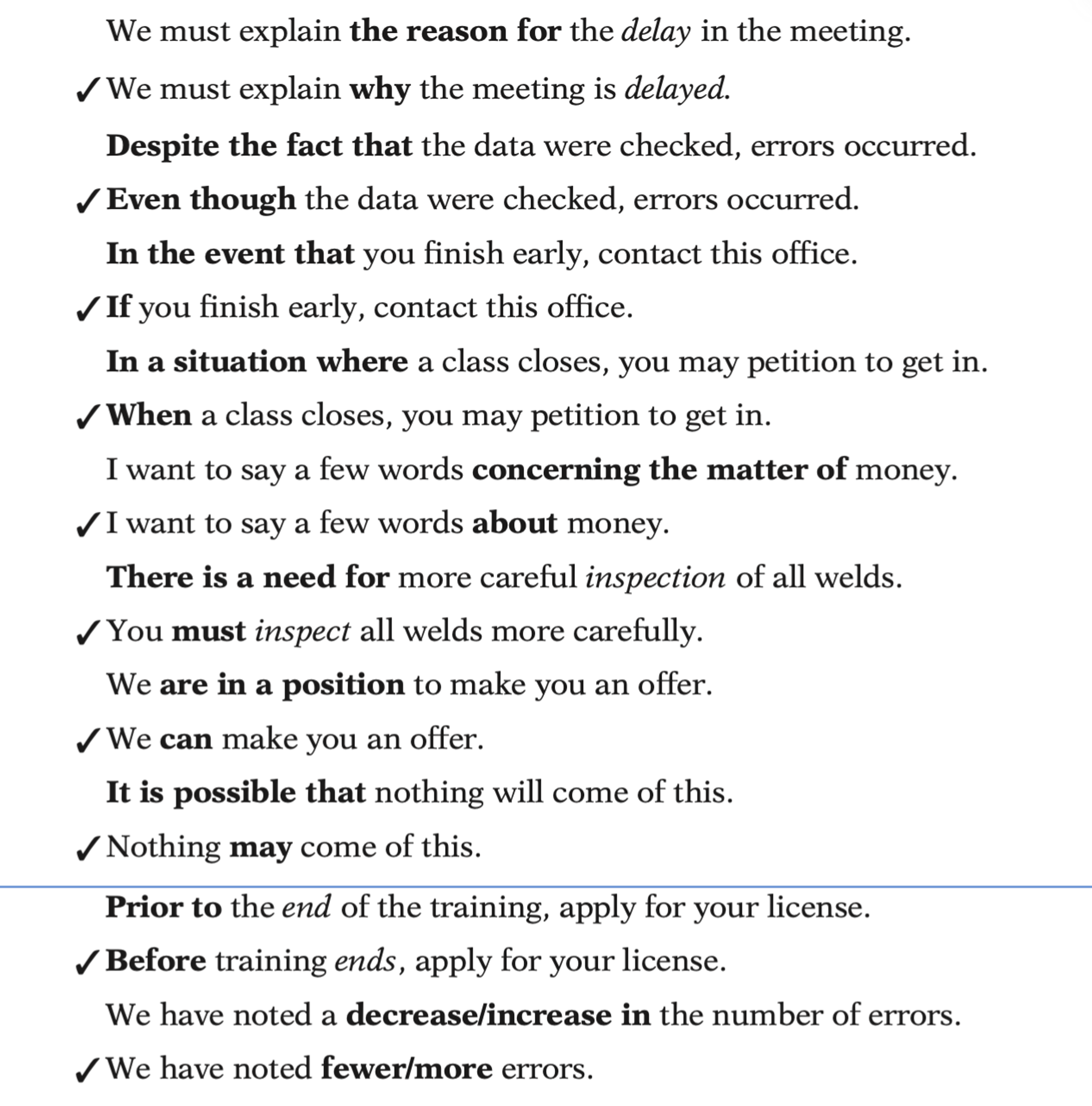
形态
- Complex sentences are necessary for complicated ideas, but can be arranged in a better way
- “Shapeless”:
- Too long before the verb in the main clause
- After the verb, they have to slog through a sprawl of tacked-on subordinate clauses
- They stumble over one interruption after another
- Avoid Long Openings
- The subject, quickly
- short if, since. when, and although
- Periodic / suspended
- The verb and object, quickly
- Avoid long, abstract subjects
- Avoid interrupting the subject–verb connection
- Avoid interrupting the verb–object connection
Exception:
Exception: when a prepositional phrase you can move is shorter than a long object, try putting the phrase between the verb and object
- Another principle: starting with your point
- Reshaping sprawl
- Cut
- Subordinate clauses → independent sentences
- Clauses to modifying phrases
- Resumptive modifires
- Summative modifiers
- Free modifiers
- Coordinate
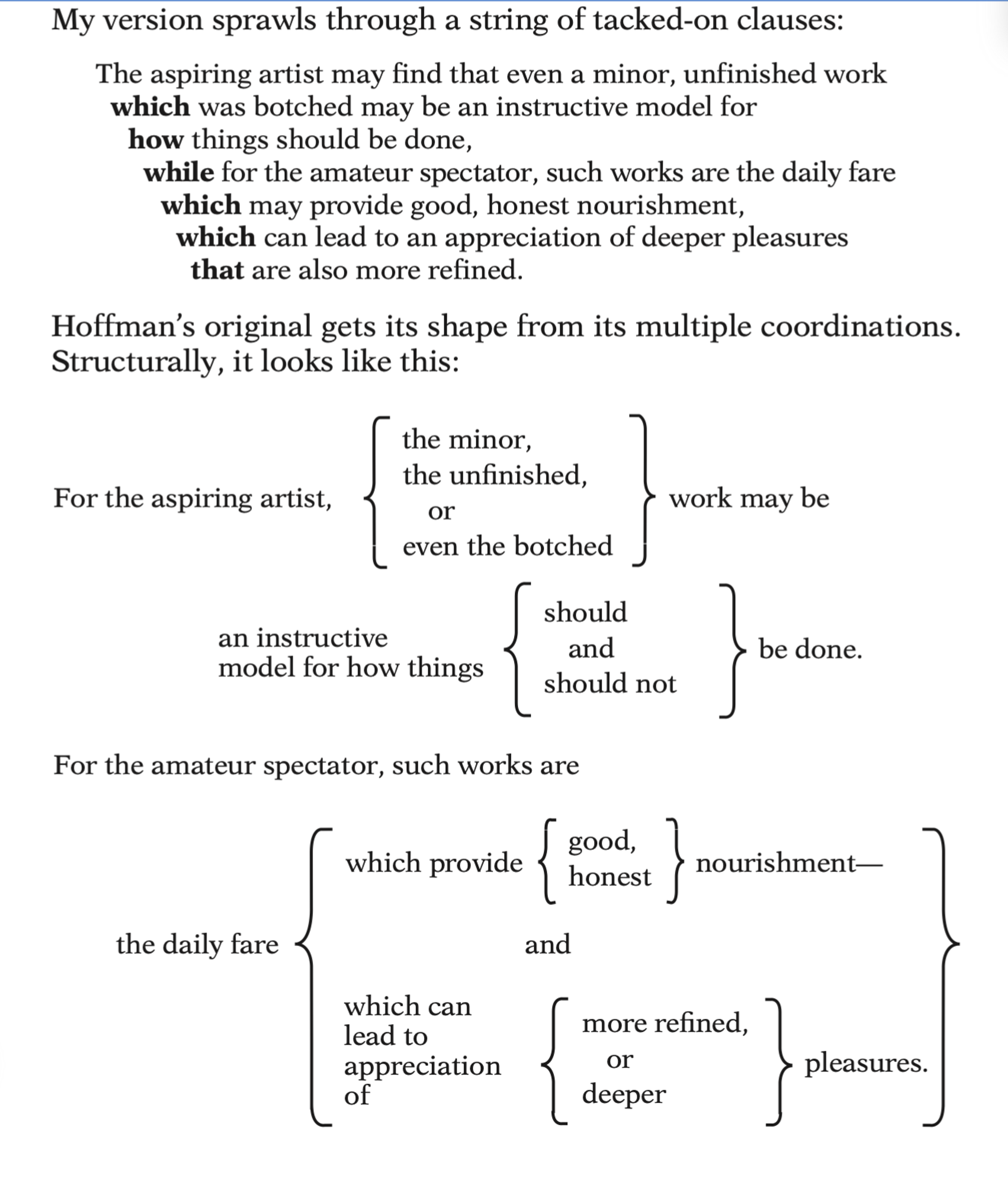
- A General Design Principle: Short to Long
- Unifying: subject-verb; old-new; logical; balanced coordination
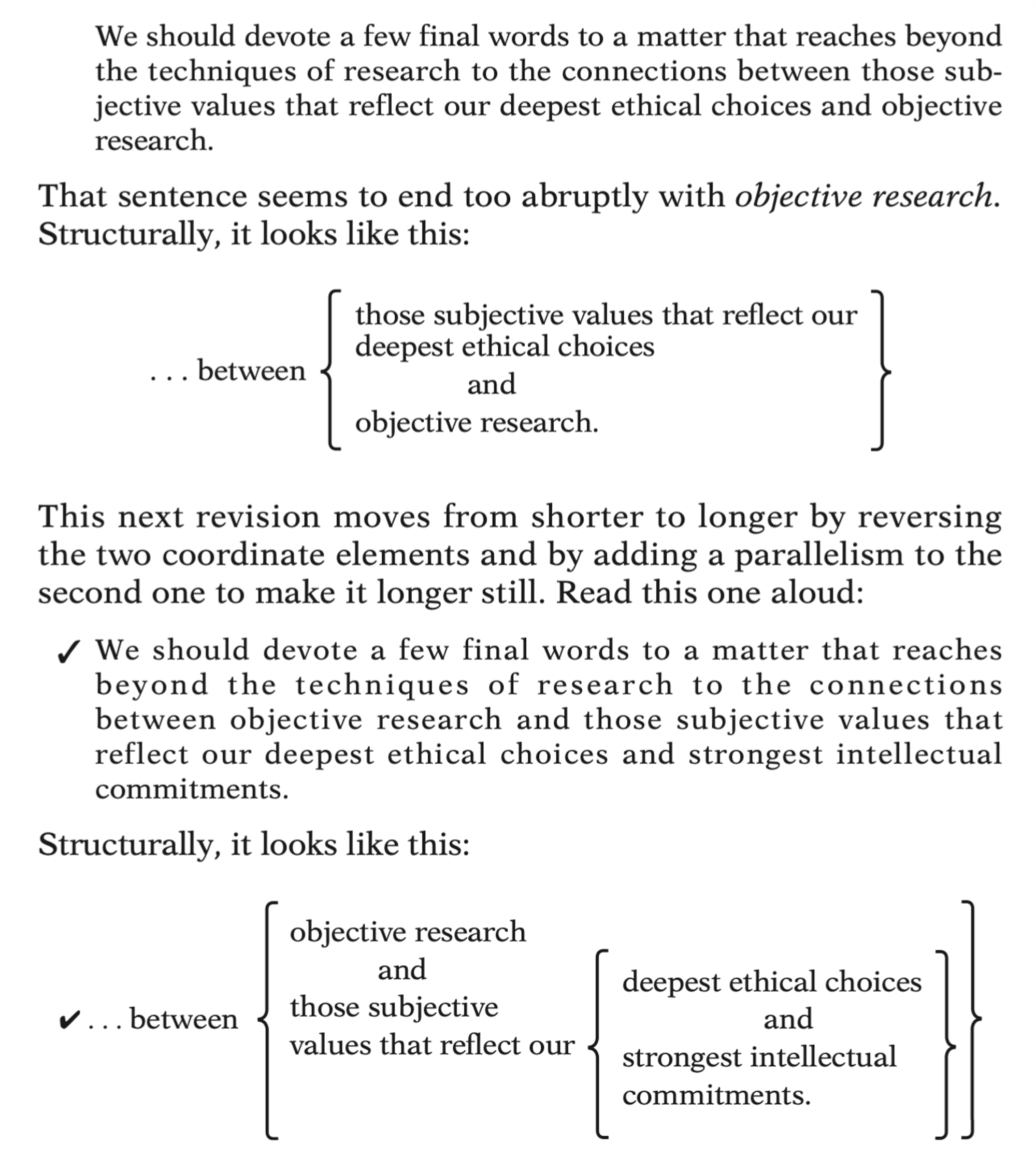
- Troubleshooting long sentences
- Grammatical
- Rhetorical
- Unclear connections
- Ambiguous modifiers: at the end → earlier
- Dangling modifiers
雅致
- Why: relentless simplicity is boring
- How
- Balance and Symmetry
- Coordinated balance
- Uncoordinated balance
- Remember that you usually create the most rhythmical balance when each succeeding balanced element is a bit longer than the previous one.
- Climactic Emphasis
- Weighty words: at the end, v./n. > adj. / adv. > prepositions
- Of + weighty word
- Echoing salience
- Chiasmus
- Suspension
- Extravagant Elegance
- Nuances of Length and Rhythm
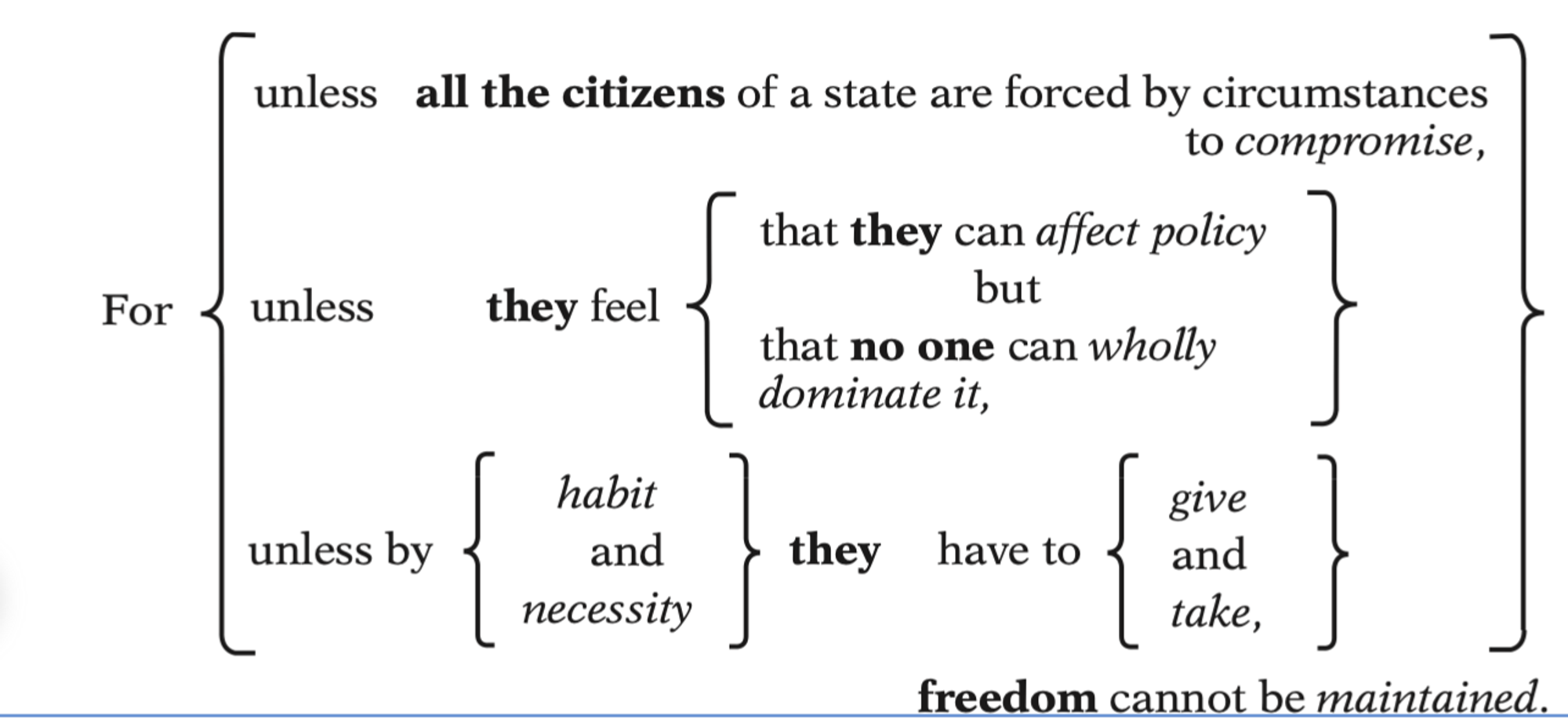
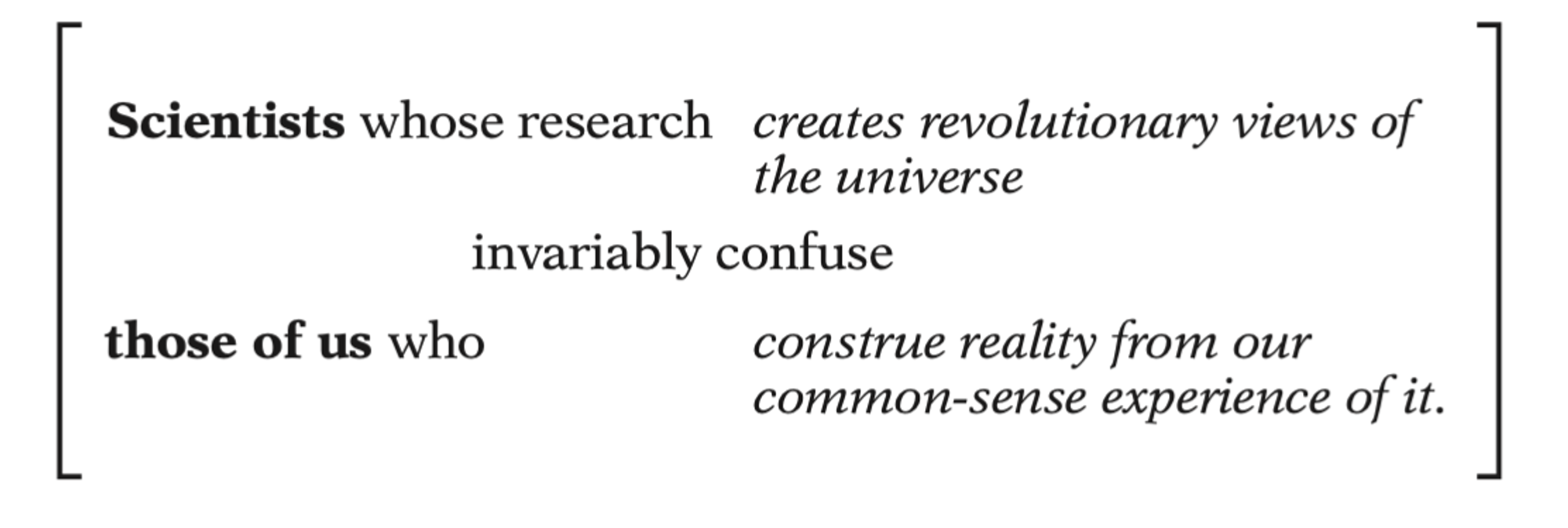
风格伦理
- Beyond Polish: the ethical dimension of our choice
- Ethical Responsibilities: write to others as you would have others write to you.
- Unintended obscurity: innocent ignorance
- Intended misdirection
- Rationalizing Opacity
- Necessary complexity
- Salutary Complexity / Subversive Clarity
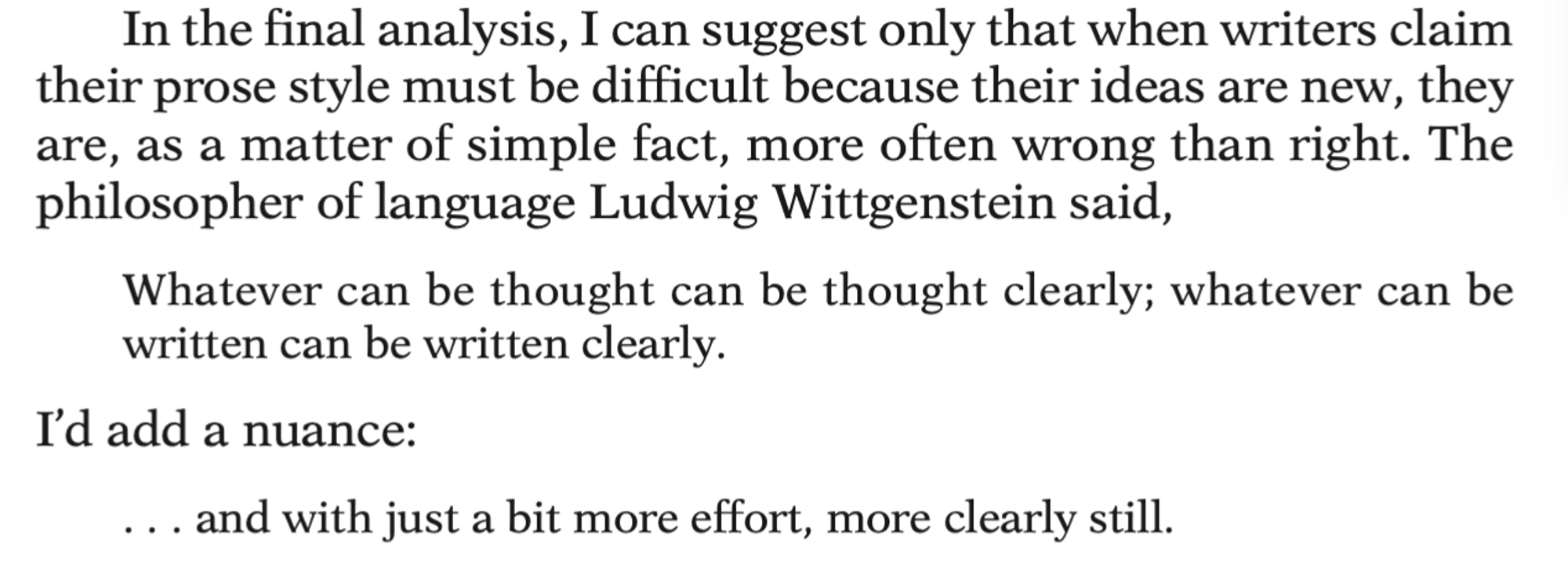
Clarity is a value that is created by society and that society must work hard to maintain, for writing clearly is not just hard: it is almost an unnatural act. It has to be learned, sometimes painfully (as this book demonstrates).
- An Extended Analysis: rhetorical power and choice
- “Good” Writing: we are ethical writers when we would willingly put ourselves in the place of our readers and experience what they do as they read what we’ve written.
- Rewards
- Pleasure
- Style as the ultimate morality of mind